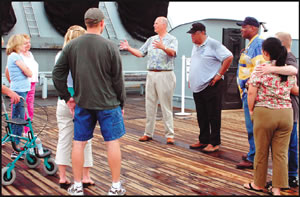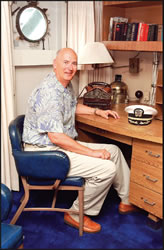Mighty Mo: The Rest of The Story
Under Capt. Don Hess’ leadership, the USS Missouri is expanding public display areas, but he’d sure like a break from the Navy on the $250 million rent

The sign for the USS Missouri Memorial is striking — not in its grandeur, but in its utter simplicity.
Plastic signage drawn over a chainlink fence, tied off with string like one would use to announce a high school dance or to advertise a happy hour special.
This is how, after five years and more than 2 million visitors, the ship that brought an end to World War II and is the last great American battleship, welcomes onlookers — like a county fair rather than a national treasure.
Righting this wrong and creating a proper tribute is the duty of retired Capt. Don Hess, who joined the staff of the Missouri Memorial Association in 1998 and took over as president in 2002.

The USS Missouri, says Hess,
closes ‘the loop’
that began on Dec. 7, 1941
“The concept was to bring the Missouri out here as a national memorial, a national icon, closing the loop that starts with USS Arizona,” says Hess, who retired in 1995 from the post of executive assistant to the commander of the U.S. Pacific Fleet.
The creation of a national icon is no easy task, with every step fraught with criticism.
It began when the MMA first won the rights to bring the “Mighty Mo” to Oahu. After choosing the pier directly in front of the Arizona Memorial, local papers began to lambaste the association in columns and editorial cartoons depicting Ferris wheels and kids with ice cream in front of the watery graves of those sailors.
“We don’t want to impact negatively the experience of the Arizona,” says Hess, who has nothing but the highest praise for the staff across the harbor. “We think we are part of the experience. We are sort of the rest of the story, but we do not want the beginning of the story to be in any way watered down.”
Hess and the board of MMA have taken several steps to ensure there is no perceived disrespect. It begins with the mooring of the Missouri facing into the harbor and toward the Arizona to “keep watch by one ship over its fallen comrade.” Ordinarily a battleship always faces out to sea, prepared to fight, but out of respect for the dead, they’ve reversed it here. This also keeps the aft section of the Missouri, where they hold countless military ceremonies, out of sight of the Arizona.
“The presentation early on was tempered by the Arizona,” says Hess, who has also kept the pier void of anything on the bow side of the Missouri. “I understand that because they have a monumental task in preserving not just a period of time, but a sense of the terrific loss that took place on Dec. 7.”
This deference toward their sunken sister vessel has led to much improved relations with the National Parks Service, which has responsibility for the Arizona memorial, helping them move toward a common goal of building a more complete visitor attraction that also includes the USS Bowfin.
With the help of state Reps. Mark Takai and Lynn Finnegan, they are working on changing the road signs to read “Pearl Harbor Historical Sites” and getting rid of the banner for good.
But Hess’ work does not end with signs and respect for fallen heroes. He still has an 887-foot, 58,000-ton “national icon” to attend to. The ship was donated to the MMA by the Navy, which means the vessel cost them nothing. Upkeep and rent for the pier, however, are overwhelming.
Though the Mighty Mo is a Navy legend, now that it belongs to a nonprofit organization it can charge them fair market value for its berth, roughly $250,000 a year. (And you thought the UH football team was getting a raw deal at nearby Aloha Stadium.)

Don Hess (center), Sam Lowe, the USS Missouri’s director
of tours and education, and volunteer supervisor Napoleon
Arline (in cap) speak with a group of visitors
“Not many museums pay that kind of rent — particularly when there is a benefit to be derived for all the military services just by the substance of the ship being here,” says Hess, insisting that there should be an exemption for the Mighty Mo.
“We think that we are exceptional, that Pearl Harbor as a historic area is unique to the United States, if not the world. The Arizona is not just a national memorial, it’s a national cemetery.”
The dream of having the two battleships, the Bowfin submarine and the new aviation museum on Ford Island, all under the umbrella of a national park may be plausible, but seems unlikely in the near future.
“In a time of tightening budgets, the last thing the Park Service needs is to take this all on, it doesn’t pass the common sense test,” says Hess, who thinks of Pearl Harbor as the Gettysburg of the Pacific. “Especially when we seem to be capable of supporting ourselves.”
They have been doing more than supporting themselves: Last year as they welcomed their 2 millionth visitor. They also paid off their $5 million debt incurred when they began refurbishing the vessel.
While churning turnstiles helps the bottom line, there would be nothing to see, according to Hess, without the outpouring from the community and the sweat of volunteers.
During the ship’s tour of duty, it carried a crew of about 1,500 sailors. Under the MMA, they have a group of a dozen guys trying to maintain the constantly rusting 60-year-old ship.
In the past five years, 42,000 volunteers have kept the Missouri ship shape. They include Outrigger Hotel cleaning crews fixing up bulkheads, a group of lawyers chipping paint or filling “bung
holes” in the teak.
“The community here is just great, and then you have the military coming over here as volunteers, all branches, and I think they are coming because of what the ship represents to them from World War II, Korea and Desert Storm,” says Hess.
Through their efforts they have been able to open new areas of the Mighty Mo. Engine Room No. 4 is now open on their Explorer’s Tour to allow visitors to see the massive steam turbines that ran the battleship at over 30 knots.
Or the newly opened Truman Line, named after the former president, who dined with the crew on one voyage in 1947. Truman refused to be allowed to cut to the front of the line every meal, insisting that he wait like everyone else.
This so impressed the sailors, they insisted that the line be henceforth named after him. Now visitors can relive those days by actually eating Navy chow in the mess hall while watching World War II movies.
These additions are nice, but Hess insists that without a military presence onboard, the experience rings hollow. This is why they allow military ceremonies (retirements, re-enlistments, new commissions) to be held on the back of the ship at no charge.

Hess at the desk of the Mighty
Mo’s captain
“We are a memorial, and it is important that we honor those who serve without them feeling like we have a hand in their pocket,” says Hess.
“It also helps bring a little military life back to the ship. The visitors get to see real military people, in uniform, doing things and giving life to the ship. So its a win-win for everyone.”
In looking to the future, they have reopened their overnight encampments for kids. Spending a night in a tiny bunk and eating Navy grub may not appeal to the average adult, but the kids are eating it up.
The night includes fire drills, cleaning duties and even a onehour watch shift the kids trade out throughout the night. Hess thinks this not only gives them an idea of what Navy life is like, it also gives them a sense of history.
As the kids tour the ship they can peer out over the bow and see the sunken hull of the USS Arizona. On the way back to their bunk they will pass the spot where Gen. MacArthur had the Japanese sign the unconditional surrender to end WWII.
Just 1,000 feet lie between the two ships. It seems impossibly close for the beginning and end of a war that claimed 55 million lives, but that is what that small stretch of turquoise water represents, and Hess wants to make sure that we never forget.
“I want people to walk away with an appreciation of the events of World War II,” says Hess. “And of the people that served, their dedication, bravery and honor. Not solely for the Missouri, but for the grander picture.”
Page 1 of 1 pages for this story
E-mail this story | Print this page | Comments (0) | Archive | RSS
Most Recent Comment(s):




 Del.icio.us
Del.icio.us



